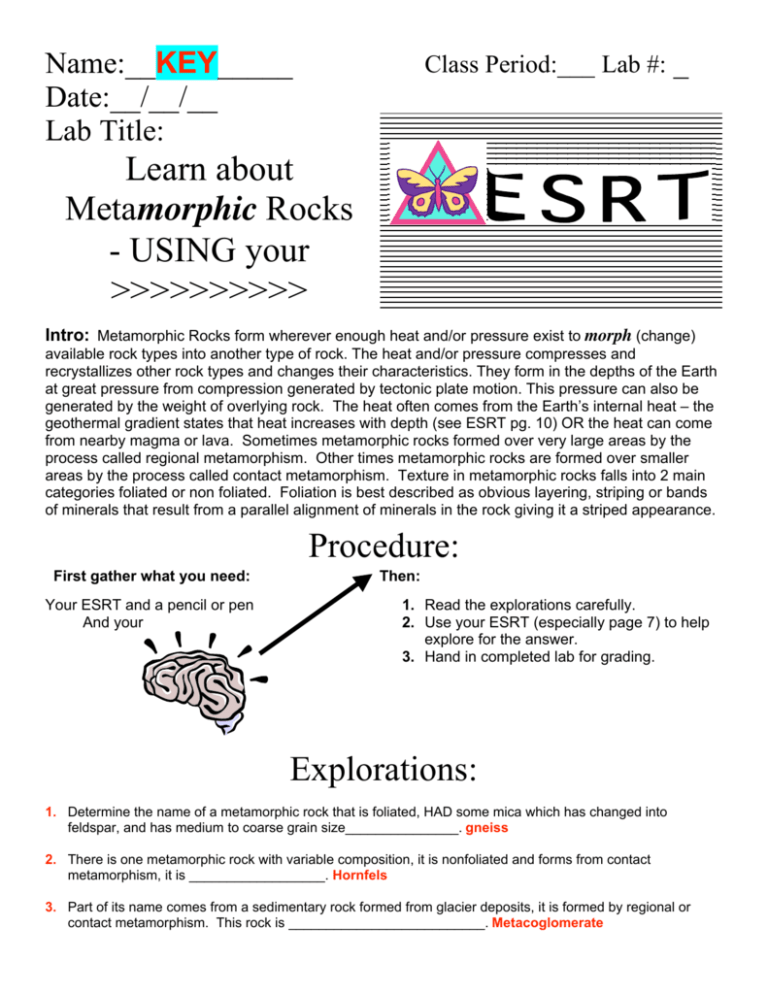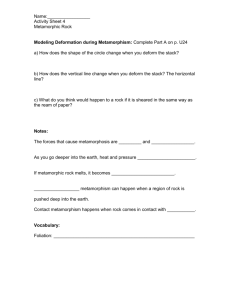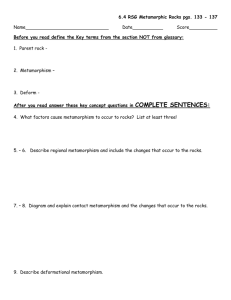Learn about Metamorphic Rocks
advertisement

Name:__KEY_____ Date:__/__/__ Lab Title: Class Period:___ Lab #: _ Learn about Metamorphic Rocks - USING your >>>>>>>>>> Intro: Metamorphic Rocks form wherever enough heat and/or pressure exist to morph (change) available rock types into another type of rock. The heat and/or pressure compresses and recrystallizes other rock types and changes their characteristics. They form in the depths of the Earth at great pressure from compression generated by tectonic plate motion. This pressure can also be generated by the weight of overlying rock. The heat often comes from the Earth’s internal heat – the geothermal gradient states that heat increases with depth (see ESRT pg. 10) OR the heat can come from nearby magma or lava. Sometimes metamorphic rocks formed over very large areas by the process called regional metamorphism. Other times metamorphic rocks are formed over smaller areas by the process called contact metamorphism. Texture in metamorphic rocks falls into 2 main categories foliated or non foliated. Foliation is best described as obvious layering, striping or bands of minerals that result from a parallel alignment of minerals in the rock giving it a striped appearance. Procedure: First gather what you need: Your ESRT and a pencil or pen And your Then: 1. Read the explorations carefully. 2. Use your ESRT (especially page 7) to help explore for the answer. 3. Hand in completed lab for grading. Explorations: 1. Determine the name of a metamorphic rock that is foliated, HAD some mica which has changed into feldspar, and has medium to coarse grain size_______________. gneiss 2. There is one metamorphic rock with variable composition, it is nonfoliated and forms from contact metamorphism, it is __________________. Hornfels 3. Part of its name comes from a sedimentary rock formed from glacier deposits, it is formed by regional or contact metamorphism. This rock is __________________________. Metacoglomerate 4. Another metamorphic rock with composition similar to a mineral AND a bioclastic sedimentary rock, also bubbles with acid, and is non foliated. Name it _____________. marble 5. This silicate based metamorphic rock is non foliated with fine to coarse grain size. It is known by the name __________________. Quartzite 6. A foliated rock showing mineral alignment and formed from regional metamorphism. It can contain mica, feldspar, quartz, garnet and amphibole. The ESRT names it ___________________Phyllite or Schist 7. With a fine grain size, it has undergone regional metamorphism, it can split easily into flat surfaces partly due to its mica content. You should call it ________________. slate 8. All metamorphic rocks are formed by one of two general types of metamorphism, these are _________________________ and _________________________ metamorphism regional & contact 9. This rock shows a kind of foliation described as ‘mineral alignment’ and does not contain pyroxene. ___________________. Phyllite or slate 10. How does contact metamorphism change rocks? __________________________________________ ________________________________________ by heat from nearby magma/lava 11. This metamorphic rock can have various mineral particles in it, and does have a coarse grain size with particles in a matrix. It is also called ________________ . metaconglomerate 12. One particular specimen starts as a clastic sedimentary rock with a grain size of 0.04 cm called _____________________. Sandstone It undergoes metamorphosis to become ____________ quartzite 13. Name 5 minerals that can be found in schist a. ____________________ b. ____________________ c. ____________________ d. ____________________ e. ____________________ Mica quartz, feldspar, amphibole, garnet, pyroxene 15. What other metamorphic rock also has the above 5 minerals in it? _______ gneiss (also Phyllite if no garnet in above) 16. Is there a metamorphic rock, that is foliated, has a fine texture, composed mainly of mica and is formed from contact metamorphism? Yes or No (circle answer) NO 17. Metamorphic rock texture is described by two major characteristics. Metamorphic rocks are either __________________ or ________________________. Foliated or nonfoliated 18. Provide the latitude and longitude of one location in New York state where there is a large area of gneiss, quartzite & marble. Give your answer to the closest minute (remember there are 60’ in 1°). Don’t forget to put directions (N, S, E, or W) on your answer. 43° - 44°45’N latitude 73°20’ - 76°W longitude 19. Write the name of each metamorphic rock type below its map symbol. marble quartzite hornfels gneiss schist slate Name:____________ Date:__/__/__ Lab Title: Class Period:___ Lab #: _ Learn about Metamorphic Rocks - USING your Intro: Metamorphic Rocks form wherever enough heat and/or pressure exist to morph (change) available rock types into another type of rock. The heat and/or pressure compresses and recrystallizes other rock types and changes their characteristics. They form in the depths of the Earth at great pressure from compression generated by tectonic plate motion. This pressure can also be generated by the weight of overlying rock. The heat often comes from the Earth’s internal heat – the geothermal gradient states that heat increases with depth (see ESRT pg. 10) OR the heat can come from nearby magma or lava. Sometimes metamorphic rocks formed over very large areas by the process called regional metamorphism. Other times metamorphic rocks are formed over smaller areas by the process called contact metamorphism. Texture in metamorphic rocks falls into 2 main categories foliated or non foliated. Foliation is best described as layering, striping or bands of minerals that result from a parallel alignment of minerals in the rock giving it a striped appearance. Procedure: First gather what you need: Your ESRT and a pencil or pen And your Then: 1. Read the explorations carefully. 2. Use your ESRT (especially page 7) to help explore for the answer. 3. Hand in completed lab for grading. Explorations: 1. Determine the name of a metamorphic rock that is foliated, HAD some mica which has changed into feldspar, and has medium to coarse grain size_______________. 2. There is one metamorphic rock with variable composition, it is nonfoliated and forms from contact metamorphism, it is __________________. 3. Part of its name comes from a sedimentary rock formed from glacier deposits, it is formed by regional or contact metamorphism. This rock is __________________________. 4. Another metamorphic rock with composition similar to a mineral AND a bioclastic sedimentary rock, also bubbles with acid, and is non foliated. Name it _____________. 5. This silicate based metamorphic rock is non foliated with fine to coarse grain size. It is known by the name __________________. 6. A foliated rock showing mineral alignment and formed from regional metamorphism. It can contain mica, feldspar, quartz, garnet and amphibole. The ESRT names it ____________________ 7. With a fine grain size, it has undergone regional metamorphism, it can split easily into flat surfaces partly due to its mica content. You should call it ________________. 8. All metamorphic rocks are formed by one of two general types of metamorphism, these are _________________________ and _________________________ metamorphism 9. This rock shows a kind of foliation described as ‘mineral alignment’ and does not contain pyroxene. ___________________. 10. How does contact metamorphism change rocks? __________________________________________ ________________________________________ 11. This metamorphic rock can have various mineral particles in it, and does have a coarse grain size with particles in a matrix.. It is also called ________________ 12. . One particular specimen starts as a clastic sedimentary rock with a grain size of 0.04 cm called _____________________. It undergoes metamorphosis to become ____________ 13. Name 5 minerals that can be found in schist a. ____________________ b. ____________________ c. ____________________ d. ____________________ e. ____________________ 15. What other metamorphic rock also has the above 5 minerals in it? ______________________ 16. Is there a metamorphic rock, that is foliated, has a fine texture, composed mainly of mica and is formed from contact metamorphism? Yes or No (circle answer) 17. Metamorphic rock texture is described by two major characteristics. Metamorphic rocks are either __________________ or ________________________. 18. Provide the latitude and longitude of one location in New York state where you can find metamorphic rocks. Give your answer to the closest minute (remember there are 60’ in 1°). Don’t forget to put directions (N, S, E, or W) on your answer. __________ latitude ________ longitude 19. Write the name of each metamorphic rock type below its map symbol.








